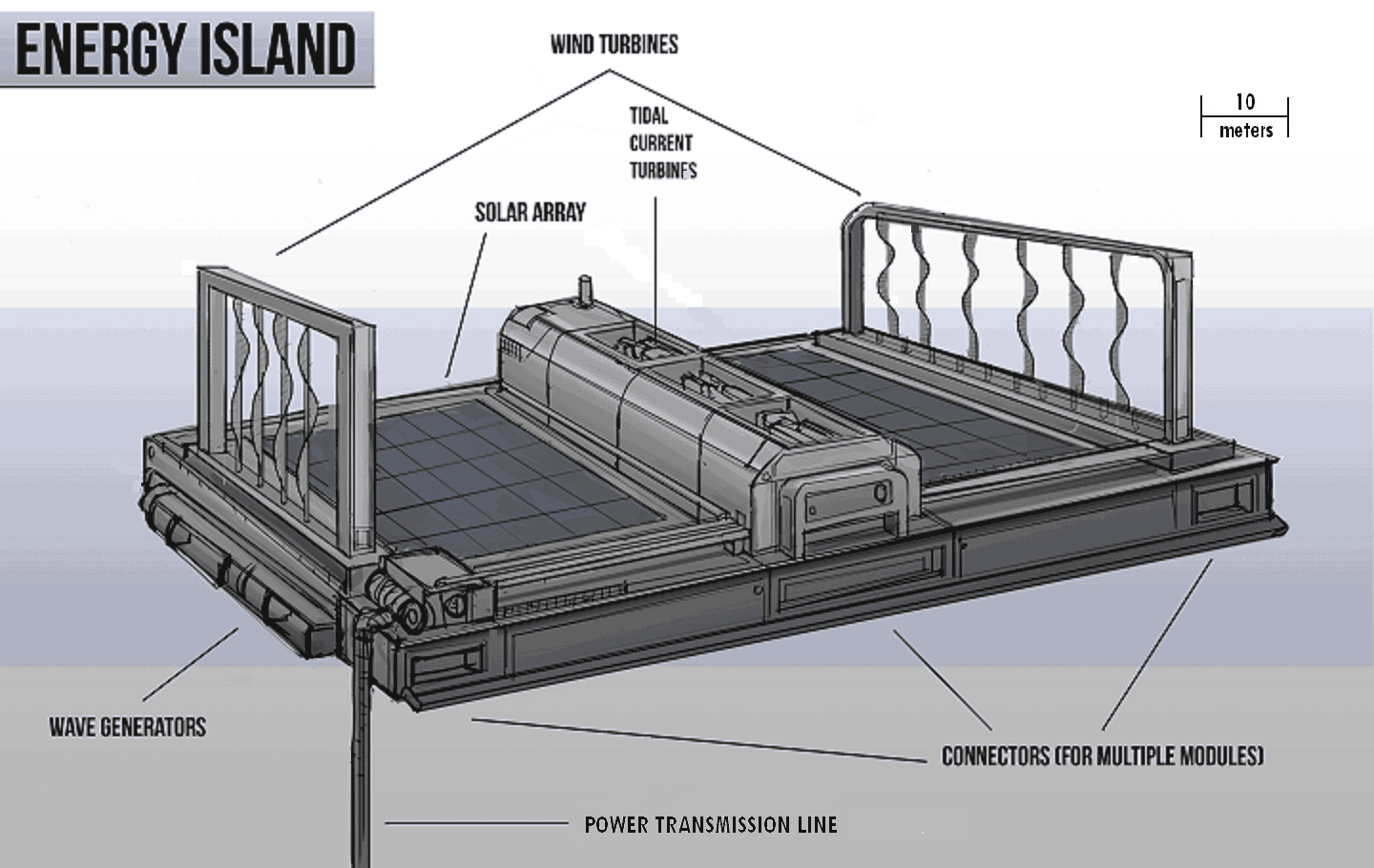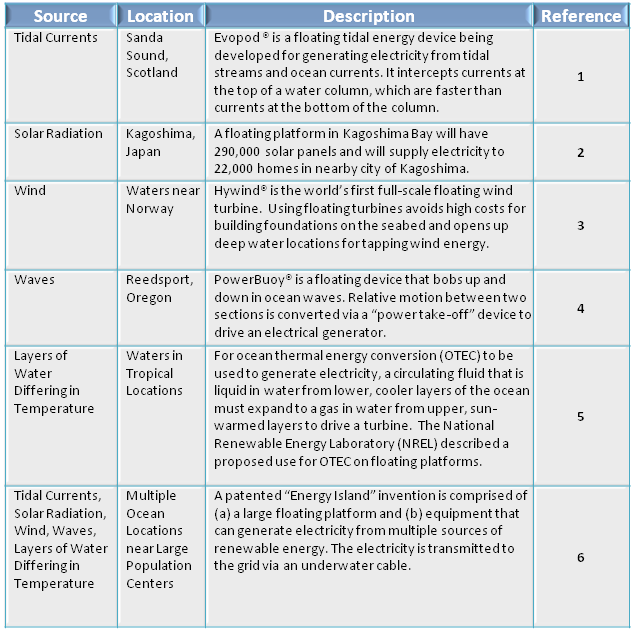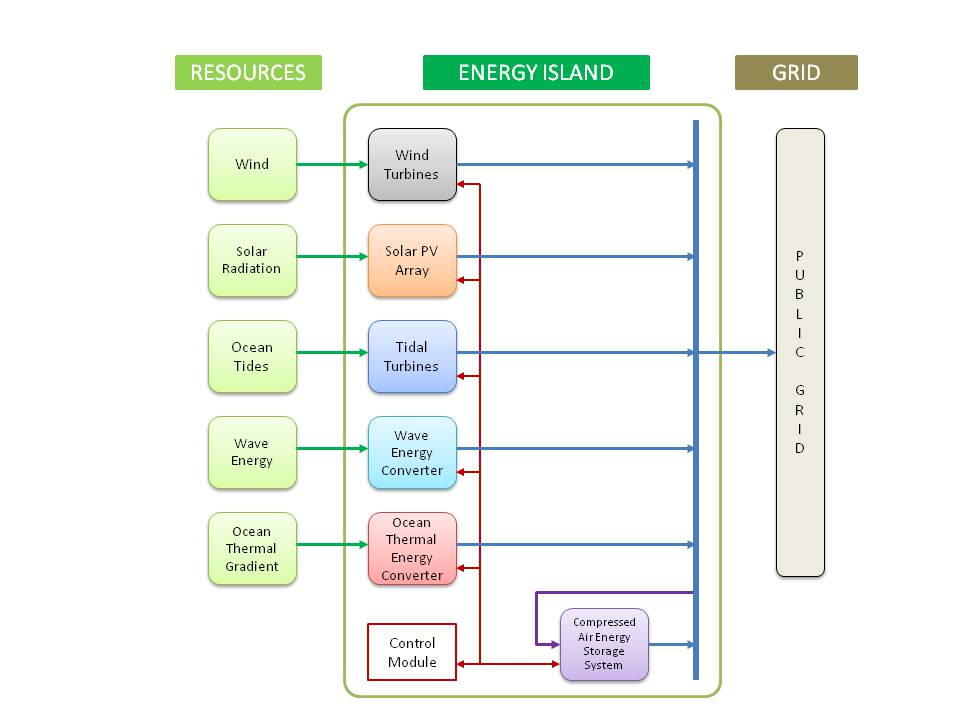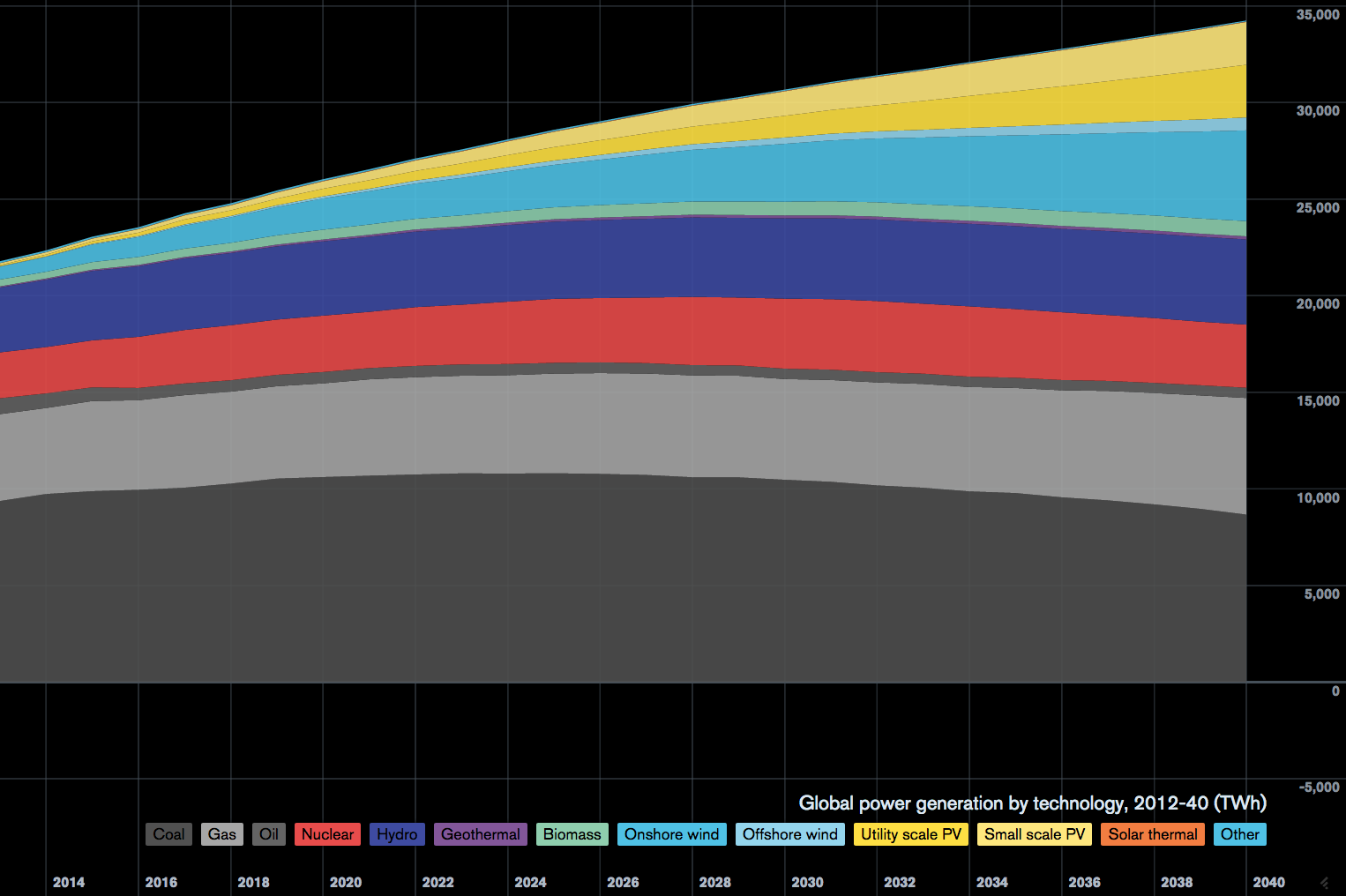Authors: Thomas Manaugh, Saïd Majdi
Pitch
Power Plant of the Future: Clean, abundant, and safe energy with no greenhouse gases.
Description
Summary

The Energy Island system uses multiple co-located sources of energy to produce clean reliable electricity to the grid. Its development is important for these reasons:
1. Energy from the oceans is tapped in a way that recognizes the enormous potential that is available. The design of Energy Island involves building a large physical structure that will allow tidal currents to be intercepted in a way to produce meaningful amounts of electricity for the grid. That large structure can also be efficiently employed — because of co-location — to provide a support for other means of using renewable energies. This design promises economies of scale and efficiencies that come from sharing physical and electrical infrastructure. The design for Energy Island is built around a critical necessity to supply electricity reliably to consumers without compromising on need to protect the environment.
2. Because multiple sources of renewable energy are co-located on Energy Island, the system can be better optimized for (a) reliability, first priority, and (b) productivity than would be possible if the system were optimized for use of just one energy source. Though the system will vary in its total output, it will be capable of guaranteeing to the grid a certain, specified minimal level of supply. That feature will help to remove one major obstacle to the acceptance of renewable energy sources as replacement for fossil fuels. The system not only provides a highly reliable supply of baseload electricity to the grid; it also is capable of providing an independent extra supply during periods of exceptional demand.Using compressed air for energy storage allows for highly reliable electricity supply while doing so in a way that promises to be cost-effective and has minimal environmental impact.
3. Though not dependent on unproven technologies to be successful, the Energy Island platform can be used to develop promising new technologies.
What actions do you propose?
Energy Needed To Replace Energy from Fossil Fuels Can Come from Oceans
There are widely and massively available sources of energy from ocean locations. Solar radiation falls predominantly on the 70% of the Earth covered by oceans. Enough energy in the form of solar radiation falls on the Earth in a few hours each day to power all human activity for an entire year.
A huge amount of kinetic energy is contained in tidal currents that are caused by gravitational effects on oceans by the sun and the moon. Energy from wind and waves is found in oceans all around the planet. In recent years a need to develop new energy sources has led to many promising developments in ocean settings. Of particular interest are efforts to mount equipment on floating platforms, thereby opening up the possibility of placing energy-tapping equipment in waters of any depth. Some highlights of those efforts are presented in Table 1 for projects proposed, now under construction, or recently completed.
Table 1. Projects for tapping energy from ocean locations using floating devices.

We propose a system to beneficially co-locate multiple means of tapping energy on a large floating platform named “Energy Island.” (6) The artist’s drawing above is but one Energy Island module among 100 connected modules that make up a very large Energy Island. The resulting very large structure promises to provide special advantages in an effort to collect significant amounts of energy from ocean locations:
1. Efficiencies come when multiple means of tapping energy share infrastructure. For example, it becomes cost-effective when one transmission line carries electricity to the grid from multiple electricity-generating modules that are co-located on Energy Island.
2. Economies of scale. Energy Island is much larger than other floating platforms that have been built or proposed for the purpose of converting renewable energies to electricity. It can, for example, benefit from a lower per unit cost when it mounts one hundred wind turbines on its top surface instead of just one.
3. Safety and ease of installing and maintaining equipment. It is easier and less expensive to install and maintain equipment on a large floating structure and not in a harsh and corrosive underwater environment.
Energy Island Co-Locates Modules to Tap Energy from Renewable Sources
Under the top surface of Energy Island’s floating platform is a narrowing duct to channel and concentrate water currents. The water flows through turbines that are located on the top surface of the platform and extend through the top surface to intercept tidal or other ocean currents with their blades. Turning of the turbines causes generators on the top surface to turn and generate electricity. Mounting turbines and generators on the top surface protects the equipment from harsh underwater conditions and vastly facilitates easy and safe installation and maintenance of the equipment.
In the patent describing Energy Island, the length is specified to be no shorter than the combined length of three aircraft carriers. The large, stable platform thus provided serves as a shared support structure for modules to tap other sources of energy besides tidal.
All modules contribute as an integrated system to the grid for distribution of electricity to consumers. Modules, in addition to the one producing electricity from tidal currents, include wind turbines for generating electricity from wind, solar photovoltaic panels for generating electricity from solar radiation, a device that floats on water and converts kinetic energy of wave movements into electricity, and a device that extends below water, where the platform is located, and generates electricity from differences in water temperature at various depths. Because large differences in water temperature at various depths are found only in limited locations, using ocean thermal energy conversion (OTEC) to generate electricity is not a means of generating electricity that could be used in most ocean locations.
Variability of Supply
Electricity is inherently variable in amount supplied when it is converted from energies of sun, wind, and waves. Though supply from converting energy of tides is predictable, it varies from high, when tides are flowing, to zero during slack tide periods.
Variability in supply from wind, sun, waves and tides is seen by some to mean that electricity from those sources cannot be relied upon by the grid to meet customers’ demands for electricity that must always be available at the flip of a switch. However, the grid can maintain reliable service to consumers by these mechanisms: The grid is able to move electricity around from one locale to a second locale to match supply to the second locale’s demand. This is possible because of a built-in flexibility of power plants and a margin that is held in reserve to maintain system reliability. However, the grid has limits in its ability to accommodate variability in supply, so the grid favors suppliers which are able to provide a guaranteed level of supply.
Utility-scale storage devices can be put in place as part of the grid. That allows energy stored during a low-demand period to be used during a high-demand period. Indeed, several storage technologies have been proposed, including batteries, hydro-electric,compressed air, superconducting magnetic energy stores, flywheels, and hydrogen-based storage systems.
The main function of renewables is to reduce reliance on the diminishing fossil fuel sources, and by so doing, reduce emissions of greenhouse gases and their negative impact on the environment. These attractive benefits will continue to support an increased penetration of renewables in the energy mix.
As penetration increases, energy storage or plant margin, or both, will also need to increase to preserve a capability of delivering a constant level of system reliability. Integration of a diverse renewable energy mix on Energy Island will reduce the variability problem for the grid that is associated with renewable energy. Because correlation of output of electricity among different renewable sources is weak, periods of low total output will tend to be reduced in frequency and duration. That is, when multiple sources of energy contribute to the total output from Energy Island, total output to the grid will be much less likely to be very low than would be the case if only one source of energy were operating.
Storage of Energy on Energy Island
Because Energy Island is designed as a floating structure, it contains some structural elements that are water-tight. Those elements can be designed to do double duty by also accommodating storage of compressed air. That makes compressed air energy storage (CAES) an obvious choice for a cost-effective means of storing energy and also one that is particularly environment-friendly. Recent advances in CAES have shown it to be a method that can rival hydropower pumping as an efficient method of storing energy (7). Unlike for batteries, components for compressed storage will not be fabricated from materials in short supply; and their eventual decommissioning will not require disposal of highly toxic chemicals. Thus, Energy Island will have its own built-in robust storage system.
Electricity generated from the energy of compressed air will be sufficient to boost supply of electricity to an acceptable level during slack-tide periods, regardless of the level of contributions toward electricity supply that come from sources of renewable energy other than tidal. Often no use of energy from storage will be needed because sufficient energy from other sources will be available during slack-tide periods. Energy Island will never need to go offline as a source of electricity for the grid because of lack of resources. Stored energy will also be available during periods of exceptional demand. Thus, extra electricity from Energy Island would be available during periods of inadequate supply from other contributors to the grid. Those periods would include periods of peak demand, e.g., during summer days when consumers use their AC units at high levels.
The diagram in Figure 1 shows how the modules of the Energy Island system are integrated in a way to provide a highly reliable and clean supply of electricity to the grid.
Figure 1. Energy Island System: A Clean and Highly Reliable System to Supply Electricity

Innovation and Optimization
Existing, well-known green technologies are specified in the innovative design of Energy Island. Though its platform could be a welcoming location to test and develop other innovative technologies, the system does not depend on such new technologies to be successful. That said, as new technologies are developed, they can be implemented on Energy Island in ways to make the system even better optimized in its use of renewable energy sources.
The top surface area of Energy Island will be extensive in order to enjoy economies of scale. Even so, the area available for installation of solar panels, wind turbines, and other devices will be limited. Thus, for optimizing the design of Energy Island, it will be important to identify types and configurations of installed equipment to generate the most amount of electricity per unit of surface area.
A group of researchers at MIT recently published results of an attempt to improve capture of solar energy. By stacking solar cells in a unique way, Bernardi et al (8) found they could capture from two times to more than 20 times more energy in a given area as would be captured by conventionally deployed cells in the same area.
Research by Dabiri (9) at Caltech has shown a ten-fold advantage in per-surface-area generation of electricity when tightly grouped vertical-axis wind turbines are used instead of conventional horizontal-axis turbines, which cannot be tightly grouped.
Thus, opportunities for cost-effective generation of electricity for a given surface area are suggested by (a) Manaugh with respect to an innovative design for co-location, (b) Bernardi et al with respect to increasing yields from solar cells and (c) Dabiri with respect to increasing yields from wind turbines.
The work of Dabiri and Bernardi et al are instances of new technologies and methods that could be used to increase the amount of energy tapped from within the space defined by the dimensions of an Energy Island. As part of the Energy Island system design, the authors have developed algorithms to maximize electric supply output by determining how much each renewable energy source contributes to that supply output at a given location.
Who will take these actions?
Electric utilities and other governmental or private entities involved in supplying electricity will need to take action.
How catastrophic will sea level rise and other consequences of global warming be if Energy Island or a comparable system is not implemented to replace the business-as-usual system for supplying electricity? Nobody actually knows how soon replacement will happen, and predictions vary widely, based on trends in growth of use of renewable energy and expectations about future demand for electricity. Some predictions are optimistic in predicting that demand for electricity will be relatively flat because of increases in efficiency of how electricity is used. Other predictions posit rising demand.
For this discussion, we accept the not-very-optimistic predictions of Tom Randal of Bloomberg Business (10) who predicts a rise in demand for electrical power of about 50 percent between his baseline year of 2012 and 2040. Electricity generated from non-fossil-fuel energy sources will grow from about 8 TWh annually to about 20 TWh annually by 2040.
Figure 1 shows a significant gap is left between the predicted continued use of fossil fuels in 2040 (continuing at a level of about 15,000 TWh per year) versus the desired level of power generation from fossil fuels — zero TWh.

Figure 1. Global power generation by technology, 2012-40. The Way Humans Get Electricity Is About to Change Forever – Randal at Bloomberg Business.
The impact of Energy Island to cope with rising demand is explored below in the section titled “How much will emissions be reduced or sequestered vs. business as usual levels?”
Where will these actions be taken?
Most humans live within 100 miles of an ocean, so energy from oceans can reach most consumers in the form of electricity without using long transmission lines. Short transmission lines reduce costs.
An Energy Island can be located in an offshore area that is near to most major population centers. Close proximity allows reduced capital costs for transmission lines and minimizes energy losses that occur when electricity is transmitted from one location to another.
Located some distance from shore, wind turbines on Energy Island will present little danger to birds and bats; and no nearby neighbors will complain about noise or visual pollution.
How much will emissions be reduced or sequestered vs. business as usual levels?
Above, we deduced an additional 15,000 TWh of “clean” electricity would need to be generated annually to allow emissions from using fossil fuels to approach zero.
Given 1800 Energy Islands, each with generation capacity of 2 GW, operated 24 hrs/day, they should theoretically be able to produce total power in a year of 1800 x 365 days x 24 hrs x 2 GW = 31,536,000 GWh = 31,536 TWh annually of electrical power.
The above calculation of power should be reduced by about half because generation output is typically 40 to 60 percent below theoretical levels. Thus, Energy Islands could be expected to produce a total yearly power output of 0.5 x 31,536 TWh = 15,768 TWh.
Therefore, the calculated output from 1800 Energy islands would be sufficient to cover the estimated extra 15,000 TWh of capacity needed by 2040 to completely eliminate the need to burn fossil fuels to generate electricity.
See Manaugh and Majdi (11) for a more detailed discussion about reducing emissions by employing Energy Islands.
What are other key benefits?
Fossil fuels are becoming less readily available, and their use must be restricted because of global warming. Those facts are not denied by the vast majority of scientists. However, there is a resistance to accepting those facts, partly because presently there is a lack of safe and proven ways to have adequate energy without using fossil fuels.
One solution to the problem of replacing fossil fuels is to tap abundant energy that can be found in ocean locations. Energy Island can be part of that solution. We are at the start of a revolutionary change in how energy is captured and used. How this change proceeds will affect every creature on planet Earth – including every human being. A fossil fuel is a finite resource, so humans’ use of fossil fuels as their major source of energy will eventually come to an end. Because fossil fuels produce greenhouse gases that contribute to global warming, replacing fossil fuels with other sources of energy must happen sooner rather than later.
What are the proposal’s costs?
As part of a global plan for wholesale replacement of fossil fuels as a primary source of energy, it is estimated that hundreds of Energy Island sites could be beneficially deployed near population centers around the globe.
The cost of an Energy Island module is derived from the cost of similar floating platforms, such as barges (www.oceanmarine.com), supplemented with CAES at $10 million plus $70 million for a generating capacity of 20 MW at an average cost of $3.50 per watt. That’s $80 million per Energy Island module, or $8 billion per Energy Island site (100 modules per site) (12).
Given that 1800 Energy Island sites will be needed to cover the estimated extra 15,000 TWh of capacity needed by 2040 to completely eliminate the need to burn fossil fuels to generate electricity, the total cost for 1800 Energy Island sites would, therefore, be $14.4 trillion.
Time line
The proposed use of Energy Island devices would, preferably, be phased in as soon as possible, given the catastrophic consequences that are sure to follow from continued burning of fossil fuels. Thus, Energy Islands should be built and deployed during the short time range of 5 to 15 years and continued during a medium time range of 15 to 50 years, during which period carbon emissions from electric power generation could be successfully brought down to zero. Thereafter (50 years plus), continued deployments of Energy Islands could occur as needed to maintain emissions at a near zero level.
Nations around the world devote more than $0.5 trillion per year to subsidizing development and use of fossil fuels (10). Ending that counter-productive practice and, instead, devoting those subsidies to building Energy Islands would allow 1800 Energy Islands (at a total cost of $14.4 trillion, as calculated above) to be built in 29 years.
The time line for reducing carbon emissions from power generation could be further shortened if funds were made available by trimming many nations’ bloated and wasteful military budgets. From military budgets totaling over $2 trillion per year, funds could be freed to build Energy Islands so that emissions could be brought to zero in the short range of under 15 years.
References
1 “Evopod” from Oceanflow Energy, Ltd., retrieved from the Internet, July 22, 2012, at http://www.oceanflowenergy.com
2 “Construction of Japan’s largest solar power plant to begin in July at a cost of ¥25 billion” by Dante D’Orazio, retrieved from the Internet, July 22, 2012, at http://www.theverge.com/2012/4/10/2939187/japan-largest-solar-power-field-kyocera-construction
3 “US and UK to collaborate on ‘floating’ wind turbines” from The Guardian on April 23, 2012, retrieved from the Internet, July 22, 2012, at http://www.guardian.co.uk/environment/2012/apr/23/us-uk-floating-wind-turbines
4 “Utility Scale Wave Power, Thanks to U.S. Navy” from CleanTechnica, retrieved from the Internet, July 29, 2012, at http://www.ethicalmarkets.com/2012/06/25/utility-scale-wave-power-thanks-to-u-s-navy
5 “Markets for OTEC” from National Renewable Energy Laboratory (NREL), retrieved from the Internet, August 1, 2012, at http://www.nrel.gov/otec/markets.html
6 “System for Generating Electricity from Alternative Energy Sources Located on a Floating Platform” by Thomas Manaugh, retrieved from the Internet, July 22, 2012, at http://patft.uspto.gov/netacgi/nph-Parser?Sect1=PTO2&Sect2=HITOFF&p=1&u=%2Fnetahtml%2FPTO%2Fsearch-bool.html&r=2&f=G&l=50&co1=AND&d=PTXT&s1=manaugh.INNM.&OS=IN/manaugh&RS=IN/manaugh
7 “LightSail Energy Could Make Compressed Air Grid-Scale Storage Work” by Herman K. Trabish in Greentechmedia:, February 23, 2012, retrieved from the Internet, August 23, 2012, at http://www.greentechmedia.com/articles/read/LightSail-Energy-Could-Make-Compressed-Air-Grid-Scale-Storage-Work/?utm_source=feedburner&utm_medium=feed&utm_campaign=Feed%3A+gridtec
8 “Potential Order-of-Magnitude Enhancement of Wind Farm Power Density via Counter-Rotating Vertical-Axis Wind Turbine Arrays” by John O, Dabiri, retrieved from the Internet, July 27, 2012, at http://arxiv.org/ftp/arxiv/papers/1010/1010.3656.pdf
9 “New Dimension for Solar Energy: Innovative 3-D Designs More Than Double the Solar Power Generated Per Area” by Marco Bernardi, Nicola Ferralis, Jin H. Wan, Rachelle Villalon, and Jeffrey C. Grossman, retrieved from the Internet, July 27, 2012, at http://www.sciencedaily.com/releases/2012/03/120327094615.htm
10 “The Way Humans Get Electricity is about to Change Forever” by Tom Randall of Bloomberg Business, 6/23/2015, at http://www.bloomberg.com/news/articles/2015-06-23/the-way-humans-get-electricity-is-about-to-change-forever
11 “Impact on Emissions of CO2 from Deploying Energy Islands” by Thomas Manaugh and Saϊd Majdi, retrieved from the Internet, June 14, 2016, at https://www.climatecolab.org:18081/contests/2014/2015-proposal-workspace/c/proposal/1322901
12 “Ocean Marine Brokerage Services,” retrieved from the Internet, June 14, 2016, at http://www.oceanmarine.com
